There are many creatures that can bite or sting humans, pets, livestock or wildlife. Many of these bites or stings can cause pain, death or reactions to our systems that can be mild to extreme. This article cannot cover all scenarios, all bites, all stings delivered by every animal or insect on the planet. It will, however, attempt to describe the different problems encountered by humans and domestic animals that are caused by insects, reptiles, and others.
Schmidt Sting Pain Index
Table of Contents
The Schmidt Sting Pain Index or The Justin O. Schmidt Pain Index is a scale rating the relative pain caused by different Hymenopteran stings. It is mainly the work of Justin O. Schmidt, an entomologist for whom the index is named. Schmidt has published a number of papers on the subject and claims to have been stung by the majority of stinging Hymenoptera.
His original paper in 1984 was an attempt to understand the role of the sting in the evolution of Hymenopteran social behavior. The index contained in the paper started from 0 for stings that are completely ineffective against humans, progressed through 2, a familiar pain such as a common bee or wasp sting, and finished at 4 for the most painful stings. Notably, Schmidt described some of the experiences in vivid and colorful detail:
Top 10 Most Painful Bites & Stings
1. Bullet Ant Bites
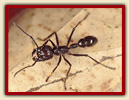 The pain caused by this insect’s sting is greater than that of any other Hymenopteran, and is ranked as the most painful according to the Schmidt Sting Pain Index.
The pain caused by this insect’s sting is greater than that of any other Hymenopteran, and is ranked as the most painful according to the Schmidt Sting Pain Index.
- 4.0+ Bullet ant: Pure, intense, brilliant pain. Like walking over flaming charcoal with a 3-inch nail in your heel.
Paraponera is a genus of a ponerine ant. The most infamous member species is the so-called bullet ant (P. clavata), named on account of its powerful and potent sting, the sensation of which has often been likened with that of being shot with a bullet by those who have had the misfortune to be at its receiving end. It is called by the locals, “Hormiga Veinticuatro,” from 24 hours of pain that follow a stinging.
2. Tarantula Hawk Stings
 It is listed near the top of the list in Schmidt Sting Pain Index. Although the sting is quite painful the effect is reported to last only a few minutes and is fatal less often than the honey bee.
It is listed near the top of the list in Schmidt Sting Pain Index. Although the sting is quite painful the effect is reported to last only a few minutes and is fatal less often than the honey bee.
- 4.0: Blinding, fierce, shockingly electric. A running hair drier has been dropped into your bubble bath (if you get stung by one you might as well lie down and scream).
The tarantula hawk is the common name for species in the genera Pepsis and Hemipepsis of the family Pompilidae, in the insect Order Hymenoptera. These genera of wasps are called tarantula hawks due to their hunting of tarantulas as food for their larvae.
3. Paper wasp Sting
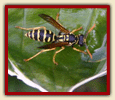 These wasps can deliver painful stings but are not as aggressive as European Wasps. They normally only attack humans if their nest is disturbed. If stings are multiple, a more severe systemic reaction may occur. In some individuals, wasp, bee and ant stings can cause an allergic reaction (anaphylaxis), but this is relatively uncommon.
These wasps can deliver painful stings but are not as aggressive as European Wasps. They normally only attack humans if their nest is disturbed. If stings are multiple, a more severe systemic reaction may occur. In some individuals, wasp, bee and ant stings can cause an allergic reaction (anaphylaxis), but this is relatively uncommon.
- 3.0 Paper wasp: Caustic & burning. Distinctly bitter aftertaste. Like spilling a beaker of Hydrochloric acid on a paper cut.
Paper wasps are 3/4 inch to 1 inch (2-2.5 cm)-long wasps that gather fibers from dried plant stems, which they mix with saliva, and use to construct water-resistant nests that appear to be made of gray or brown papery material. Paper wasps are also sometimes called umbrella wasps, due to the distinctive design of their nests.
4. Red harvester Ant Bites
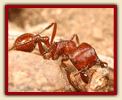 Red Harvester Ants can be aggressive and have a painful sting that spreads through the lymph nodes, sometimes causing reactions, especially in those allergic to their venom. In addition to their potent sting, Red Harvester ants can bite ferociously.
Red Harvester Ants can be aggressive and have a painful sting that spreads through the lymph nodes, sometimes causing reactions, especially in those allergic to their venom. In addition to their potent sting, Red Harvester ants can bite ferociously.
- 3.0 Red harvester ant: Bold and unrelenting. Somebody is using a drill to excavate your ingrown toenail.
Their chief food source usually consists of seeds, which they hoard in great numbers, hence their name. As with most ant species, their mating castes consist of winged alates (reproductives) that reside in the nest until weather permits them to fly away and mate, after which the male usually dies, and the now-fertilized queen returns to the ground to search for a suitable nesting site.
5. Honey Bee & European Hornet Stings
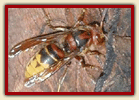 European Hornets are often (although wrongly) thought to be very aggressive and dangerous, and are greatly feared by some people. Some people believe that “three stings from the European hornet can kill an adult human, and that seven can kill a horse”.
European Hornets are often (although wrongly) thought to be very aggressive and dangerous, and are greatly feared by some people. Some people believe that “three stings from the European hornet can kill an adult human, and that seven can kill a horse”.
- 2.x Honey bee and European hornet.
Honey bees (or honeybees) are a subset of bees which represent a far smaller fraction of bee diversity than most people suspect; of the approximately 20,000 known species of bees, there are only seven presently-recognized species with a total of 44 subspecies.
6. Yellow Jacket Sting
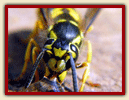 If a colony is disturbed, Yellowjackets can become very aggressive and sting. For most a sting is temporary, but painful, but for allergic individuals as single sting may result in a serious reaction, requiring medical treatment.
If a colony is disturbed, Yellowjackets can become very aggressive and sting. For most a sting is temporary, but painful, but for allergic individuals as single sting may result in a serious reaction, requiring medical treatment.
- 2.0 Yellowjacket: Hot and smoky, almost irreverent. Imagine WC Fields extinguishing a cigar on your tongue.
Yellowjackets are black-and-yellow wasps of the genus Vespula or Dolichovespula (some can be black-and-white, the most notable of these being the bald-faced hornet, Dolichovespula maculata). They can be identified by their distinctive combination of black-and-yellow color, small size (slightly larger than a bee), and entirely black antennae.
7. Bald-faced hornet Sting
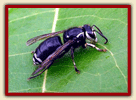 Unlike bees, the poison of wasps and hornets is not really intended for use against us. Wasps and hornets are mainly hunters of insects, while bees collect nectar, to make honey. With large amounts of honey in an average honey bee nest, the main purpose of a bee sting is to defend the nest and the colony against any attack, from mice and other animals, right up to humans.
Unlike bees, the poison of wasps and hornets is not really intended for use against us. Wasps and hornets are mainly hunters of insects, while bees collect nectar, to make honey. With large amounts of honey in an average honey bee nest, the main purpose of a bee sting is to defend the nest and the colony against any attack, from mice and other animals, right up to humans.
- 2.0 Bald-faced hornet: Rich, hearty, slightly crunchy. Similar to getting your hand mashed in a revolving door.
The Bald-faced hornet, Dolichovespula maculata is not a true hornet at all. It is actually more closely related to another type of wasp called the yellowjacket than it is to true hornets like the Asian giant hornet or European hornet, but the term “hornet” is often used colloquially to refer to any vespine with an exposed aerial nest.
8. Bullhorn Acacia Sting
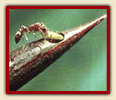 Getting stung in the mouth and tongue is an effective deterrent to browsing on the tender foliage. In addition to protecting A. conigera from leaf-cutting ants and other unwanted herbivores, the ants also clear away invasive seedlings around the base of the tree that might overgrow it and block out vital sunlight.
Getting stung in the mouth and tongue is an effective deterrent to browsing on the tender foliage. In addition to protecting A. conigera from leaf-cutting ants and other unwanted herbivores, the ants also clear away invasive seedlings around the base of the tree that might overgrow it and block out vital sunlight.
- 1.8 Bullhorn acacia ant: A rare, piercing, elevated sort of pain. Someone has fired a staple into your cheek.
The ants act as a defense mechanism for the tree, protecting it against harmful insects, animals or humans that may come into contact with it. The ants live in the hollowed-out thorns for which the tree is named after. In return, the tree supplies the ants with protein-lipid nodules called Beltian bodies from its leaflet tips and carbohydrate-rich nectar from glands on its leaf stalk.
9. Fire Ant Bite
Unlike many other ants, which bite and then spray acid on the wound, fire ants only bite to get a grip and then sting (from the abdomen) and inject a toxic alkaloid venom (piperidine). For humans, this is a painful sting, which leaves a sensation similar to what one feels when they get burned by fire — hence the name fire ant — and the aftereffects of the sting can be deadly to sensitive individuals. The venom is both insecticidal and antibiotic
- 1.2 Fire ant: Sharp, sudden, mildly alarming. Like walking across a shag carpet & reaching for the light switch.
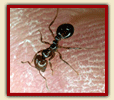 A typical fire ant colony produces large mounds in open areas and feeds mostly on young plants, seeds, and sometimes crickets. Fire ants often attack small animals and can kill them. Unlike many other ants, which bite and then spray acid on the wound, fire ants only bite to get a grip and then sting (from the abdomen) and inject a toxic alkaloid venom (piperidine).
A typical fire ant colony produces large mounds in open areas and feeds mostly on young plants, seeds, and sometimes crickets. Fire ants often attack small animals and can kill them. Unlike many other ants, which bite and then spray acid on the wound, fire ants only bite to get a grip and then sting (from the abdomen) and inject a toxic alkaloid venom (piperidine).
10. Sweat Bee Sting
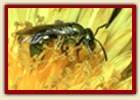 Their attraction to sweat makes them a nuisance. Their sting hurts, but the pain only lasts around 10 minutes.
Their attraction to sweat makes them a nuisance. Their sting hurts, but the pain only lasts around 10 minutes.
- 1.0 Sweat bee: Light, ephemeral, almost fruity. A tiny spark has singed a single hair on your arm.
Sweat bee is the common name for bees that are attracted to pollen and the salt in human perspiration. In its strict application, the name refers to members of the Halictidae, a large family of bees that are common in most of the world except Australia and Southeast Asia, where they are only a minor faunistic element.
